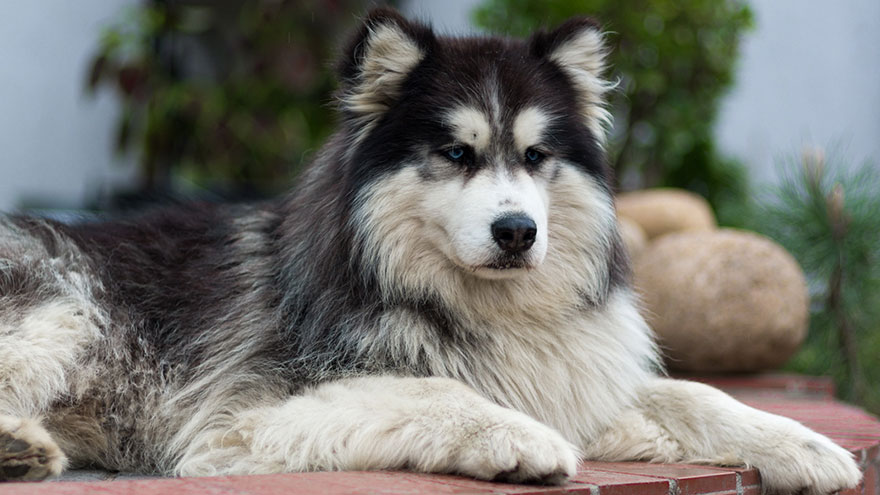Alaskan Malamute : 10 Most Common Questions
Anytime a person buys a new dog, it is imperative to learn everything possible about that breed, its history, potential health risks, traits, and so on. The more you know about the breed, the better you understand the appropriate way to way and train. With the Alaskan Malamute being such an exceptional breed, we see the number of people making this a family pet growing. To help get you started with information, we wanted to address the top 10 questions pertaining to the Malamute.

1. What is the background of the Alaskan Malamute?
This particular breed was actually named after the Mahlemuts tribe in Alaska. Living on the shores of the Kotzebue Sound in the upper western part of the state, the Malamute was exposed to bitterly cold conditions, which is why this breed has a double coat and preference for cooler climates.
2. Is the Alaskan Malamute related to any other dog breeds?
Although the Malamute is a native Artic breed, it is also a close cousin to the Siberian Husky, Samoyed from Russia, Labradors, and Eskimo dogs of Greenland. Yes, there are differences, but in all the breeds, you see similarities to include strong muscles and gentle nature.
3. I have heard that the Alaskan Malamute does not bark – is that true?
Well the answer is both yes and no. The Malamute will bark but the sound produced is much different from what you hear coming from other breeds. For the Alaskan Malamute, the sound is more of a “woo woo” sound. In fact, the noise made by the character Chewbacca in the famous Star Wars film was based on the sound of a Malamute owned by George Lucas. In addition, when this breed becomes lonely or excited, howling is quite common.
4. Are Malamutes diggers?
In the wilderness, this breed would typically dig as a means of finding food. When kept as a pet, the Malamute will often use its digging instincts when bored. However, when in the backyard, if your dog should smell or see any type of critter such as a mouse or mole, expect him to go crazy trying to capture the prey.
5. I know the Alaskan Malamute is a large breed but how big does this dog actually get?
Typically, the male Malamute will reach a height between 24 and 26 inches while the female runs approximately 23 to 25 inches from the withers. As far as weight, this breed will run as much as 125 pounds for males, although 95 to 105 is normal, and the females are usually a little smaller – weighing in around 75 to 90 pounds.
6. Is the Alaskan Malamute good with kids?
Although this breed is large, muscular, and powerful, with a proud stance, it is a gentle breed. The Malamute is very loyal to its family, providing a nice balance of protection and love.
7. I have heard that the Malamute is not a good choice of dog if you have other dogs – is this true?
Well, the Alaskan Malamute will get along with other dogs but usually if raised and socialized together. However, this breed does have a natural tendency toward animal aggression in that it was bred and used for hunting purposes. Therefore, you need to keep an upper hand at all times. On the other hand, the Malamute does not usually do well around other dogs and animals when in a public setting such as the park. For this reason, this breed should be maintained on a leash and handled by a strong person anytime away from the house.
8. How much should I expect to pay for an Alaskan Malamute puppy?
The price for this breed will depend on a number of factors. For instance, if you were buying a flawless dog from a reputable breeder for show, then the price would be more than if buying a sub-par puppy from a private party. On average, you would expect to pay anywhere from $500 to $1,500 or more.
9. Is this breed difficult to care for?
Actually, the Alaskan Malamute is easy to care for but it does have some specific requirements. Remember, the coat is double and thick. Therefore, we recommend daily brushing to keep the hair healthy while cutting down on shedding. For bathing, the Malamute should be bathed only every three to four months. Since they shed dirt along with hair, they do not get very dirty. Then for exercise, the Malamute is relatively active. For this reason, daily exercise in the form of training, walking, jogging, or playing is necessary.
10. How easy is the Malamute to train?
This breed is strong and powerful, meaning it is important that the owner take his or her place as master. While this breed is exceptionally bright, it can also be a little on the stubborn side. Therefore, proper training by a professional is strongly recommended. Keep in mind that we also suggest you be involved with the trainer, working alongside him/her and the dog for the most success.
Read More About : Alaskan Malamute
- Alaskan Malamute Breed Information
- Alaskan Malamute Training Guide
- Owning an Alaskan Malamute : Breeder Recommendations
- Alaskan Malamute Health Guide
Check out the video version of this article on YouTube

